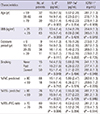1. Schins RP, Borm PJ. Mechanisms and mediators in coal dust induced toxicity: a review. Ann Occup Hyg. 1999; 43:7–33.
2. Vanhée D, Molet S, Gosset P, Tillie-Leblond I, Boitelle A, Wallaert B, Tonnel AB. Expression of leucocyte-endothelial adhesion molecules is limited to intercellular adhesion molecule-1 (ICAM-1) in the lung of pneumoconiotic patients: role of tumour necrosis factor-alpha (TNF-α). Clin Exp Immunol. 1996; 106:541–548.
3. Soutar CA, Collins HP. Classification of progressive massive fibrosis of coalminers by type of radiographic appearance. Br J Ind Med. 1984; 41:334–339.
4. Kelley J. Cytokines of the lung. Am Rev Respir Dis. 1990; 141:765–788.
5. Wolpe SD, Davatelis G, Sherry B, Beutler B, Hesse DG, Nguyen HT, Moldawer LL, Nathan CF, Lowry SF, Cerami A. Macrophages secrete a novel heparin-binding protein with inflammatory and neutrophil chemokinetic properties. J Exp Med. 1988; 167:570–581.
6. Nario RC, Hubbard AK. Silica exposure increases expression of pulmonary intercellular adhesion molecule-1 (ICAM-1) in C57Bl/6 mice. J Toxicol Environ Health. 1996; 49:599–617.
7. Lee JS, Shin JH, Lee JO, Lee KM, Kim JH, Choi BS. Serum levels of interleukin-8 and tumor necrosis factor-alpha in coal workers' pneumoconiosis: one-year follow-up study. Saf Health Work. 2010; 1:69–79.
8. International Labour Organization. International Labour Organization (ILO) Guidelines for the use of the ILO international classification of radiographs of pneumoconiosis. Revised ed. Geneva: International Labour Organization;2002. (Occupational Safety and Health Series; no 22).
9. Miller MR, Hankinson J, Brusasco V, Burgos F, Casaburi R, Coates A, Crapo R, Enright P, van der, Gustafsson P, et al. ATS/ERS Task Force. Standardisation of spirometry. Eur Respir J. 2005; 26:319–338.
10. Morris JF, Koski A, Johnson LC. Spirometric standards for healthy non-smoking adults. Am Rev Respir Dis. 1971; 103:57–67.
11. Gulumian M, Borm PJ, Vallyathan V, Castranova V, Donaldson K, Nelson G, Murray J. Mechanistically identified suitable biomarkers of exposure, effect, and susceptibility for silicosis and coal-worker's pneumoconiosis: a comprehensive review. J Toxicol Environ Health B Crit Rev. 2006; 9:357–395.
12. Khalil N, O'Connor RN, Unruh HW, Warren PW, Flanders KC, Kemp A, Bereznay OH, Greenberg AH. Increased production and immunohistochemical localization of transforming growth factor-beta in idiopathic pulmonary fibrosis. Am J Respir Cell Mol Biol. 1991; 5:155–162.
13. Donaldson K, Brown GM, Brown DM, Robertson MD, Slight J, Cowie H, Jones AD, Bolton RE, Davis JM. Contrasting bronchoalveolar leukocyte responses in rats inhaling coal mine dust, quartz, or titanium dioxide: effects of coal rank, airborne mass concentration, and cessation of exposure. Environ Res. 1990; 52:62–76.
14. Arbabi S, Garcia I, Bauer GJ, Maier RV. Alcohol (ethanol) inhibits IL-8 and TNF: role of the p38 pathway. J Immunol. 1999; 162:7441–7445.
15. Missale G, Ferrari C, Fiaccadori F. Cytokine mediators in acute inflammation and chronic course of viral hepatitis. Ann Ital Med Int. 1995; 10:14–18.
16. Laso FJ, Vaquero JM, Almeida J, Marcos M, Orfao A. Production of inflammatory cytokines by peripheral blood monocytes in chronic alcoholism: relationship with ethanol intake and liver disease. Cytometry B Clin Cytom. 2007; 72:408–415.
17. Bittleman DB, Casale TB. Interleukin-8 mediates interleukin-1 alpha-induced neutrophil transcellular migration. Am J Respir Cell Mol Biol. 1995; 13:323–329.
18. Strieter RM, Chensue SW, Basha MA, Standiford TJ, Lynch JP, Baggiolini M, Kunkel SL. Human alveolar macrophage gene expression of interleukin-8 by tumor necrosis factor-α, lipopolysaccharide, and interleukin-1β. Am J Respir Cell Mol Biol. 1990; 2:321–326.
19. Kim KA, Lim Y, Kim JH, Kim EK, Chang HS, Park YM, Ahn BY. Potential biomarker of coal workers' pneumoconiosis. Toxicol Lett. 1999; 108:297–302.
20. Osborn L. Leukocyte adhesion to endothelium in inflammation. Cell. 1990; 62:3–6.
21. Bevilacqua MP, Stengelin S, Gimbrone MA Jr, Seed B. Endothelial leukocyte adhesion molecule 1: an inducible receptor for neutrophils related to complement regulatory proteins and lectins. Science. 1989; 243:1160–1165.
22. Guzman J, Izumi T, Nagai S, Costabel U. ICAM-1 and integrin expression on isolated human alveolar type II pneumocytes. Eur Respir J. 1994; 7:736–739.
23. Wang GZ, Wang MJ, Liu LH, Wang JH, Qin WH, Liu Y, He JF. The surface biomarkers of sputum cells in coal mine workers and patients with pneumoconiosis. Zhonghua Lao Dong Wei Sheng Zhi Ye Bing Za Zhi. 2011; 29:837–840.
24. Driscoll KE, Hassenbein DG, Carter J, Poynter J, Asquith TN, Grant RA, Whitten J, Purdon MP, Takigiku R. Macrophage inflammatory proteins 1 and 2: expression by rat alveolar macrophages, fibroblasts, and epithelial cells and in rat lung after mineral dust exposure. Am J Respir Cell Mol Biol. 1993; 8:311–318.
25. Zhang W, Wang R, Wang X, Zhou XB, Wang H, Zhang HD, Liu ZL. Changes of cell factor in bronchoalveolar lavage fluid in rats exposed to silica. Zhonghua Lao Dong Wei Sheng Zhi Ye Bing Za Zhi. 2013; 31:801–805.
26. Langford D, Masliah E. Role of trophic factors on neuroimmunity in neurodegenerative infectious diseases. J Neurovirol. 2002; 8:625–638.








 PDF
PDF ePub
ePub Citation
Citation Print
Print



 XML Download
XML Download